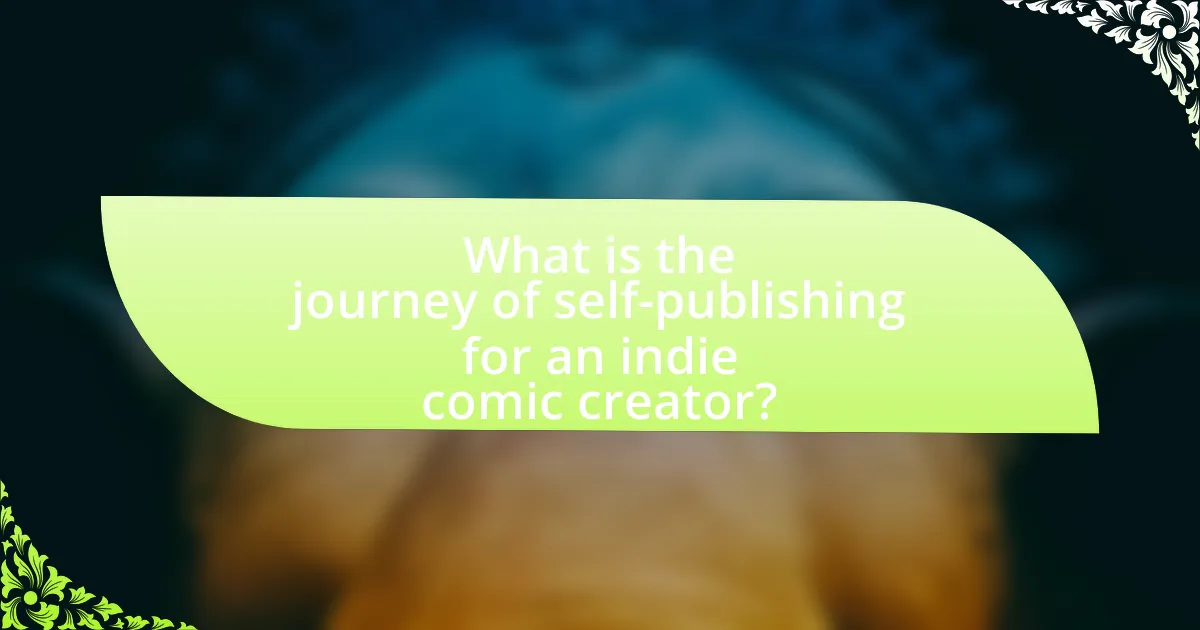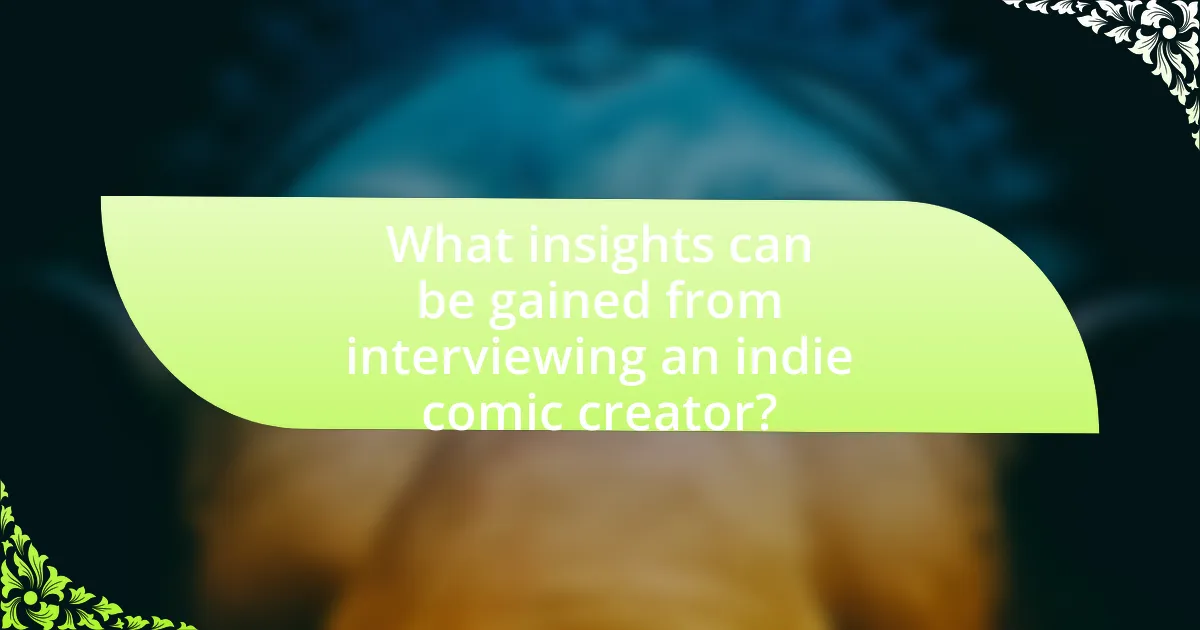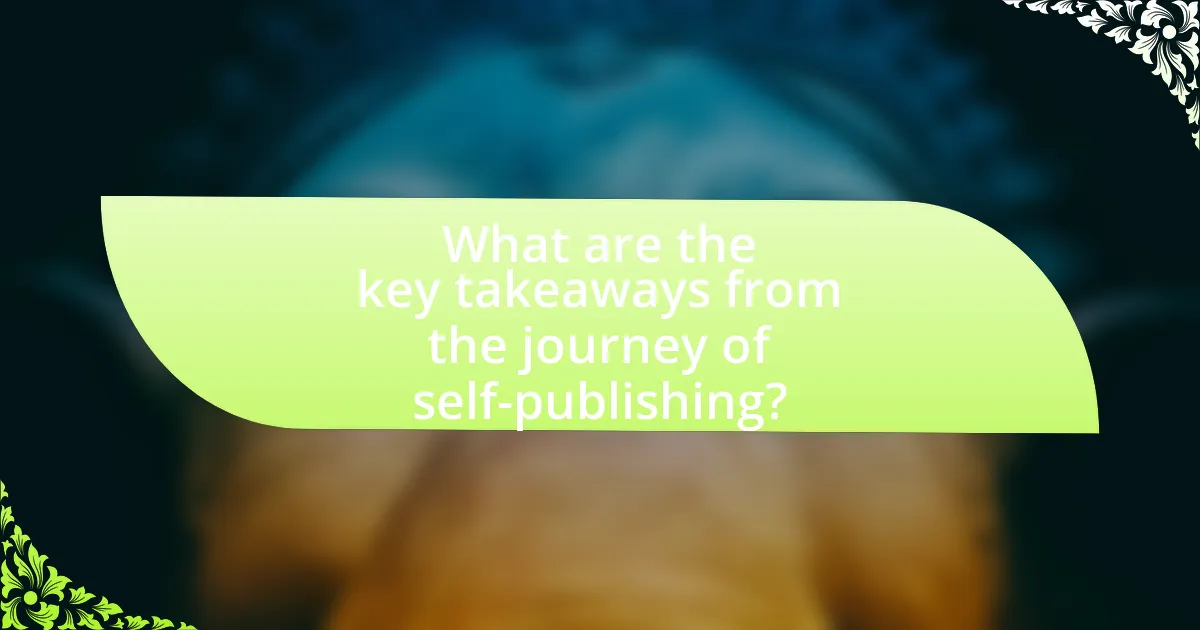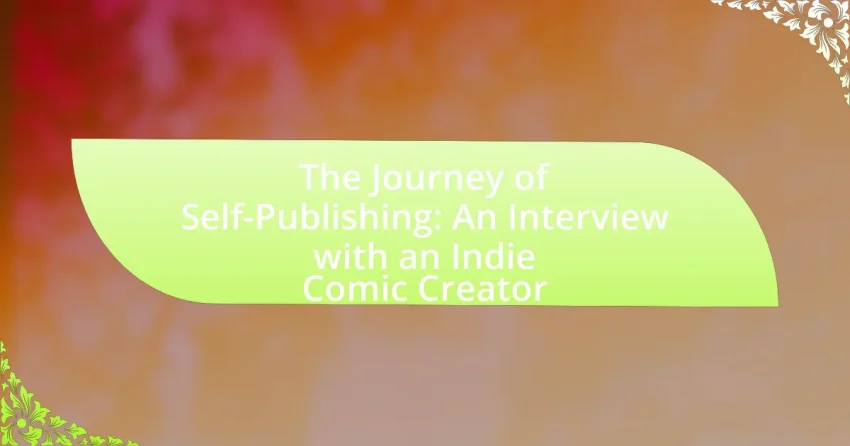The article focuses on the journey of self-publishing for indie comic creators, detailing the essential stages including concept development, creation, production, marketing, and distribution. It contrasts self-publishing with traditional publishing, highlighting the creative control and financial independence that self-publishing offers. Key challenges faced by indie creators, such as financial constraints and marketing difficulties, are discussed, along with the skills necessary for success. The article also explores the importance of social media in promoting comics, emerging trends in the indie comic space, and provides insights from an interview with an indie comic creator, emphasizing lessons learned and strategies for long-term success.

What is the journey of self-publishing for an indie comic creator?
The journey of self-publishing for an indie comic creator involves several key stages: concept development, creation, production, marketing, and distribution. Initially, the creator develops a unique concept and storyline, which is crucial for engaging potential readers. Following this, the creator illustrates and writes the comic, often collaborating with artists or writers to enhance the quality.
Once the comic is completed, the creator moves to production, which includes formatting the comic for print and digital platforms. This stage often involves selecting a printing service or using platforms like ComiXology or Kickstarter for funding and distribution.
Marketing is essential for reaching an audience; creators utilize social media, comic conventions, and online communities to promote their work. Finally, distribution involves selling the comic through various channels, including online stores, local comic shops, and direct sales at events.
This structured approach is supported by the fact that many successful indie comic creators have utilized these stages to build their brands and reach audiences, as evidenced by the rise of platforms like Webtoon and Tapas, which have democratized comic publishing.
How does self-publishing differ from traditional publishing in comics?
Self-publishing in comics allows creators full control over their work, including content, design, and distribution, while traditional publishing involves collaboration with a publisher who manages these aspects. In self-publishing, creators retain all rights and profits, enabling them to directly engage with their audience through platforms like Kickstarter or webcomics. Conversely, traditional publishing typically requires creators to cede some rights and share profits with the publisher, who also handles marketing and distribution, often leading to wider reach but less creative freedom. This distinction is evident in the rise of successful self-published comics, such as “Scott Pilgrim” by Bryan Lee O’Malley, which gained popularity through grassroots marketing and direct fan engagement, contrasting with traditional routes that may prioritize established franchises.
What are the key steps involved in the self-publishing process?
The key steps involved in the self-publishing process include writing, editing, designing, formatting, publishing, and marketing the work. First, the author writes the manuscript, ensuring it meets their creative vision. Next, editing is crucial for refining the content, which may involve professional editors to enhance clarity and coherence. Following editing, the design phase includes creating a cover and layout that attract readers, often requiring graphic design skills or hiring a designer. Formatting the manuscript for various platforms, such as eBooks or print, is essential to ensure compatibility with publishing standards. Once the manuscript is ready, the author can publish through platforms like Amazon Kindle Direct Publishing or IngramSpark, which provide access to a wide audience. Finally, marketing strategies, including social media promotion and book signings, are vital for reaching potential readers and driving sales. Each of these steps is critical for a successful self-publishing journey.
What challenges do indie comic creators face in self-publishing?
Indie comic creators face significant challenges in self-publishing, primarily including financial constraints, marketing difficulties, and distribution issues. Financially, many creators struggle to fund production costs such as printing, artwork, and distribution, often relying on personal savings or crowdfunding platforms. Marketing poses another hurdle, as indie creators typically lack the resources and networks that established publishers have, making it hard to reach a wider audience. Additionally, distribution can be problematic; indie comics often have limited access to retail outlets and may rely heavily on online sales, which can be competitive and saturated. These challenges highlight the complexities of navigating the self-publishing landscape for indie comic creators.
Why do indie comic creators choose self-publishing?
Indie comic creators choose self-publishing primarily for creative control and financial independence. By self-publishing, these creators retain full ownership of their work, allowing them to express their unique artistic vision without interference from traditional publishers. Additionally, self-publishing enables them to keep a larger share of the profits, as they are not bound by the revenue-sharing models typically imposed by publishing houses. According to a survey conducted by the Independent Publishers Association, over 70% of indie creators reported that self-publishing allowed them to reach their target audience more effectively and maintain their artistic integrity.
What creative freedoms does self-publishing offer?
Self-publishing offers creators complete control over their content, allowing them to make decisions regarding storylines, art styles, and marketing strategies without external constraints. This autonomy enables authors and artists to express their unique visions and cater directly to their target audiences. For instance, a survey by the Independent Book Publishers Association found that 80% of self-published authors reported satisfaction with their creative control, highlighting the significant advantage of self-publishing in fostering individual expression and innovation in storytelling.
How does self-publishing impact financial returns for creators?
Self-publishing significantly enhances financial returns for creators by allowing them to retain a larger percentage of sales revenue compared to traditional publishing. In traditional publishing, authors typically receive royalties ranging from 5% to 15% of the book’s sale price, while self-published creators can earn up to 70% of their sales through platforms like Amazon Kindle Direct Publishing. This higher revenue share enables creators to profit more directly from their work, leading to increased financial returns. Additionally, self-publishing eliminates the need for intermediaries, allowing creators to set their own prices and control marketing strategies, further optimizing their earnings potential.
What skills are essential for successful self-publishing?
Successful self-publishing requires strong writing, marketing, and design skills. Writing skills are essential for creating engaging content that resonates with readers, while marketing skills help authors effectively promote their work to reach a wider audience. Design skills are important for producing visually appealing covers and layouts that attract potential buyers. According to a survey by the Alliance of Independent Authors, 70% of successful self-published authors reported that effective marketing strategies significantly contributed to their sales success.
How important is marketing for indie comic creators?
Marketing is crucial for indie comic creators as it directly influences their visibility and sales. Without effective marketing strategies, even high-quality comics may go unnoticed in a saturated market. For instance, a study by the Comic Book Legal Defense Fund indicates that 70% of independent creators rely on social media to promote their work, highlighting the necessity of digital marketing in reaching potential readers. Additionally, successful campaigns often lead to increased crowdfunding support, as evidenced by the fact that projects with strong marketing efforts on platforms like Kickstarter tend to exceed their funding goals by an average of 30%. Thus, marketing is not just important; it is essential for the success and sustainability of indie comic creators.
What role does social media play in promoting self-published comics?
Social media plays a crucial role in promoting self-published comics by providing creators with platforms to reach a wider audience and engage directly with fans. Through channels like Instagram, Twitter, and Facebook, indie comic creators can showcase their work, share updates, and build a community around their comics. For instance, a study by the University of Southern California found that 70% of independent creators reported increased visibility and sales through social media marketing efforts. This direct interaction not only fosters a loyal fan base but also allows creators to receive immediate feedback, which can inform future projects and marketing strategies.
How can indie comic creators navigate the self-publishing landscape?
Indie comic creators can navigate the self-publishing landscape by leveraging digital platforms, utilizing social media for marketing, and engaging with their audience directly. Digital platforms like Kickstarter and Patreon provide funding opportunities and community support, allowing creators to finance their projects while building a fanbase. Social media channels such as Instagram and Twitter enable creators to showcase their work, connect with readers, and promote their comics effectively. Engaging with the audience through newsletters or interactive content fosters loyalty and feedback, which is crucial for growth. According to a 2021 survey by the Comic Book Legal Defense Fund, 70% of indie creators reported that social media significantly impacted their visibility and sales, underscoring the importance of these tools in the self-publishing journey.
What resources are available for aspiring indie comic creators?
Aspiring indie comic creators have access to various resources that can aid in their development and success. Key resources include online platforms like Webtoon and Tapas for digital publishing, which allow creators to reach a wide audience without significant upfront costs. Additionally, crowdfunding platforms such as Kickstarter and Indiegogo provide financial support for projects, enabling creators to fund their comic production. Educational resources, including books like “Making Comics” by Scott McCloud and online courses from sites like Skillshare and Udemy, offer valuable insights into storytelling, art techniques, and the business side of comics. Furthermore, communities on social media platforms like Reddit and Discord facilitate networking and collaboration among creators, providing a space for feedback and support. These resources collectively empower indie comic creators to navigate the complexities of self-publishing effectively.

What insights can be gained from interviewing an indie comic creator?
Interviewing an indie comic creator provides insights into the creative process, challenges of self-publishing, and the evolving landscape of the comic industry. These creators often share their unique approaches to storytelling, illustrating the importance of personal voice and artistic vision in their work. Additionally, they discuss practical aspects such as funding, marketing strategies, and audience engagement, revealing how they navigate the complexities of bringing their projects to life. For instance, many indie creators utilize crowdfunding platforms, which have become essential for financing their projects, highlighting a shift in how comics are produced and distributed. This firsthand knowledge can inform aspiring creators about the realities of the industry and inspire innovative approaches to their own work.
What personal experiences shaped the creator’s journey?
The creator’s journey was shaped by a combination of childhood experiences, artistic influences, and challenges faced in the publishing industry. Growing up, the creator was inspired by comic books and graphic novels, which fostered a passion for storytelling and illustration. Additionally, facing obstacles such as limited resources and initial rejections from traditional publishers motivated the creator to pursue self-publishing as a means to share their work. These experiences collectively informed the creator’s unique perspective and determination to succeed in the indie comic scene.
How did the creator overcome initial obstacles in self-publishing?
The creator overcame initial obstacles in self-publishing by leveraging online resources and building a supportive community. They utilized platforms like social media and crowdfunding to gain visibility and financial backing, which helped them navigate challenges such as marketing and distribution. Additionally, the creator engaged with other indie authors and participated in workshops, which provided valuable insights and strategies for overcoming common hurdles in the self-publishing process.
What lessons did the creator learn from their successes and failures?
The creator learned that perseverance is crucial for overcoming challenges, as evidenced by their ability to continue producing work despite initial setbacks. They also recognized the importance of audience feedback, which helped refine their storytelling and art style, leading to increased engagement and sales. Additionally, they discovered that financial management is vital, as miscalculating production costs in earlier projects resulted in losses, emphasizing the need for careful budgeting in future endeavors.
What advice does the creator have for new indie comic artists?
The creator advises new indie comic artists to focus on storytelling and character development as foundational elements of their work. Strong narratives and relatable characters engage readers and enhance the overall impact of the comic. Additionally, the creator emphasizes the importance of consistent practice and seeking feedback from peers to improve skills and refine their craft. This approach is supported by the fact that many successful indie comics have gained popularity through compelling stories and character arcs, demonstrating that these elements resonate with audiences.
What common mistakes should new creators avoid?
New creators should avoid underestimating the importance of planning and research. Many new creators jump into projects without a clear strategy, which can lead to wasted resources and time. For instance, a survey by the Creative Industries Federation found that 60% of new creators who failed cited lack of market research as a primary reason for their struggles. Additionally, neglecting to build an audience before launching can hinder success; creators should engage with potential fans early to establish a following. Lastly, overlooking the significance of professional quality in their work can diminish credibility; studies show that high-quality visuals and storytelling are crucial for attracting and retaining an audience.
How can new creators effectively build their audience?
New creators can effectively build their audience by leveraging social media platforms to engage with potential fans and showcase their work. Utilizing platforms like Instagram, Twitter, and TikTok allows creators to share content, connect with followers, and participate in relevant communities. According to a 2021 survey by Hootsuite, 73% of marketers believe that their efforts through social media marketing have been “somewhat effective” or “very effective” for their business, highlighting the importance of these platforms in audience growth. Additionally, consistent content creation and interaction with the audience foster loyalty and encourage word-of-mouth promotion, which is crucial for expanding reach.
What future trends are emerging in the indie comic self-publishing space?
Emerging trends in the indie comic self-publishing space include increased use of digital platforms, crowdfunding for financing, and a focus on niche markets. Digital platforms like Webtoon and Tapas are gaining popularity, allowing creators to reach wider audiences without traditional publishing barriers. Crowdfunding platforms such as Kickstarter and Indiegogo are becoming essential for funding projects, with successful campaigns often raising thousands of dollars, demonstrating community support and interest. Additionally, indie creators are targeting niche genres and diverse storytelling, reflecting a growing demand for representation and unique voices in the comic industry. This trend is supported by data showing that diverse comics have seen significant sales growth, indicating a shift in consumer preferences.
How is technology influencing the self-publishing process?
Technology is significantly influencing the self-publishing process by providing creators with accessible tools for writing, designing, and distributing their work. Digital platforms like Amazon Kindle Direct Publishing and IngramSpark enable authors to publish their books with minimal upfront costs, allowing for greater financial independence. Additionally, software for graphic design and layout, such as Adobe InDesign and Canva, empowers creators to produce professional-quality visuals without needing extensive training or resources. The rise of social media and online marketing tools further enhances visibility and audience engagement, enabling self-published authors to reach global markets directly. According to a 2021 report by the Independent Book Publishers Association, self-publishing has grown by 40% in the past five years, underscoring the impact of technology on democratizing the publishing landscape.
What new platforms are gaining popularity among indie creators?
New platforms gaining popularity among indie creators include Patreon, Ko-fi, and Substack. These platforms provide unique monetization opportunities and community engagement features that cater specifically to independent artists and writers. For instance, Patreon allows creators to offer subscription-based content, enabling them to earn a steady income while building a loyal fanbase. Ko-fi facilitates one-time donations and offers a shop feature for creators to sell their work directly. Substack has emerged as a favored platform for writers, allowing them to publish newsletters and monetize their audience through subscriptions. The rise of these platforms reflects a growing trend towards direct creator-to-consumer relationships, empowering indie creators to sustain their work financially.

What are the key takeaways from the journey of self-publishing?
The key takeaways from the journey of self-publishing include the importance of creative control, the necessity of effective marketing, and the value of community engagement. Creative control allows authors to maintain their vision and voice, which is crucial for authenticity. Effective marketing strategies, such as leveraging social media and crowdfunding platforms, are essential for reaching a wider audience; for instance, successful self-published authors often utilize platforms like Kickstarter to fund their projects and build a fanbase. Community engagement fosters support and feedback, which can enhance the quality of the work and increase visibility; many indie creators find success through networking with other artists and participating in conventions. These elements collectively contribute to a successful self-publishing experience.
What best practices can enhance the self-publishing experience?
To enhance the self-publishing experience, authors should prioritize thorough editing, professional cover design, and effective marketing strategies. Thorough editing ensures that the content is polished and free of errors, which is crucial for maintaining credibility; studies show that well-edited works receive higher ratings and reviews. Professional cover design significantly impacts first impressions, as research indicates that visually appealing covers can increase sales by up to 50%. Effective marketing strategies, such as leveraging social media and building an author platform, are essential for reaching a wider audience; data from the Author Earnings Report highlights that authors who actively engage in marketing see a notable increase in their book sales.
How can indie comic creators maintain motivation throughout their journey?
Indie comic creators can maintain motivation throughout their journey by setting clear, achievable goals and regularly celebrating small milestones. This approach helps to create a sense of progress and accomplishment, which is crucial for sustaining enthusiasm. Research indicates that goal-setting can enhance motivation by providing direction and a framework for measuring success. For instance, a study published in the Journal of Applied Psychology found that individuals who set specific and challenging goals performed better than those who did not, reinforcing the importance of structured objectives in creative endeavors. Additionally, engaging with a supportive community of fellow creators can provide encouragement and accountability, further bolstering motivation.
What strategies can help in achieving long-term success in self-publishing?
To achieve long-term success in self-publishing, authors should focus on building a strong brand and engaging with their audience consistently. Establishing a recognizable brand helps differentiate an author in a crowded market, while regular interaction with readers fosters loyalty and community. Research indicates that authors who actively engage with their audience through social media and newsletters see a significant increase in book sales and reader retention. For instance, a study by the Alliance of Independent Authors found that 70% of successful self-published authors prioritize audience engagement as a key strategy for sustained success.
